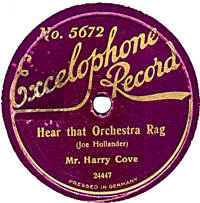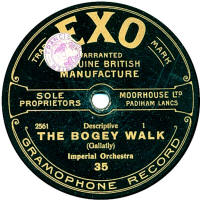Thanks to Bill Dean-Myatt for providing the label image.
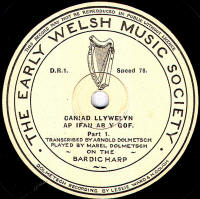
Price was 3/- each.
My thanks to Norman Field for providing the label scan.

The 10" discs had an E-100 catalogue series and 12" were in the E-500 range, but it is not known how many different ones were issued.
The organist and composer, Francis Jackson, who is the performer on most of the records, was the incumbant organist at York Minster at the time.
Thanks to Bill Dean-Myatt for providing the label image.
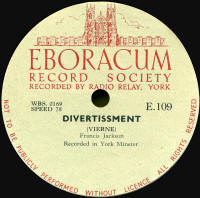
Thanks to Bill Dean-Myatt for providing the label image.
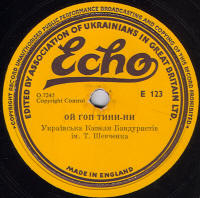
It is not known for who these records were made, but it is thought they were pressed by Globophon in Germany, using their own recordings, which have a 3-digit matrix number, and London recordings, which are in a 6000 series. The catalogue numbers may also be more than one series, with the 100- range being band and instrumental and the 300-range being vocal, but note a solitary 200- series in the listing just to make things difficult!
Thanks to Ray Stephenson for the label photo.
_small.jpg)
The very much more common 8" Eclipse record was launched in April 1931 and was available at only 6d from Woolworth's. The recording quality was good, as was the material. To keep the costs down, one side was usually a non-copyright song bought outright from the composer or publisher. All masters were English, and the catalogue started sensibly at 1 and ran to 1011 by July 1935 when they were discontinued. There was also a blue-labelled SC-1 series for more serious music, which ran up to SC-160.
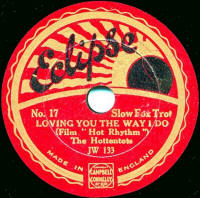
Edison also produced a long-playing vertical cut version of the Diamond disc, and, amazingly, these also seemed to have made their way to the UK, judging by the example, right. (Apologies for the low quality of this image.)
In the summer of 1929, the Edison company started producing standard lateral cut grooved records and it appears these were also imported into the UK, though only one known example has turned up in recent years. The Edison company ceased production in October 1929.
The popular (50000) series were sold at 5/6 and the standard (80000) series were 8/6. The high price, combined with the fact you needed a special (and expensive) machine to play them has ensuree that they remained rare.
The laterals were a cheaper at about 3/6, but still expensive: about the same price as an HMV record, but without the prestigious named artists.
Thanks to Bill Dean-Myatt for the scan of the Edison lateral.
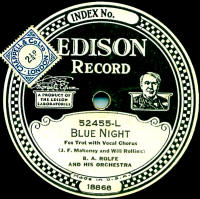
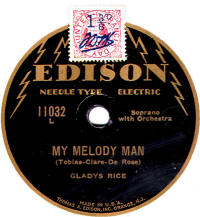
The second image is of an interesting historic recording. Apart from all the build-up about Florence Nightingale, the record concludes with a dubbing of Nightingale's own voice, taken from a very much earlier recording (she died in 1910; this record dates from the early 1930s). The words she speaks are quoted on the sleeve (see photo). The label describes the record as "19th century celebrity series No 1". As far as I am aware, this was the first and only issue in this series!
Click here to hear the recording of Florence Nightingale's voice (dated 1890)
Note: The records issued as "Edison Bell Electron", "Edison Bell Radio", "Edison Bell Velvet Face" and "Edison Bell Winner" will be found under Electron, Radio, Velvet Face and Winner respectively.
_small.jpg)
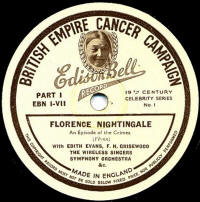
As all issues were of piano solos, I assume the label name refers to the 88 notes on the piano.
I only have details of two issues, thanks to Richard Prout for providing these: Please let me know if there were any more.
| Cat No | Matrix No | Title | Artists |
| 881 | PP-1 | Powerhouse Boogie Woogie | Cyril Scutt (piano) |
| 881 | PP-2 | Rockin' The Blues | Cyril Scutt (piano) |
| 882 | PP-3 / O.1526 | Delta Express | Cyril Scutt (piano) |
| 882 | PP-4 / O.1527 | Steady Stomp Boogie | Cyril Scutt (piano) |
Thanks to Robert GIrling for providing the label image.

Please e-mail me with details of ANY of these records. Also a scan.
Thanks to Bill Dean-Myatt for providing the label image.
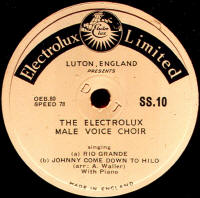
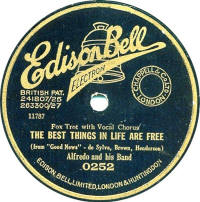
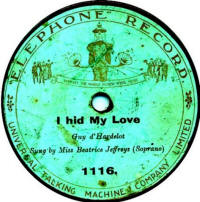

The main catalogue series started at WB-101, running up to the WB-400s by 1961 when the format changed to 45rpm only. The highest 78rpm I've seen a reference to is WB-433, issued in January 1961.
There was another short series of specials with different prefixes of CR (children;'s record), PT (party time), HT (holiday time) and XC (Christmas). These used one number series starting at 100 and running to just 107 as far as I know. The CR-series had a special label (see right), the others used the standard red with silver printing. Links to other sites regarding this label: Embassy Records Woolworth's Museum
Thanks to Bill Dean-Myatt for providing the label images.
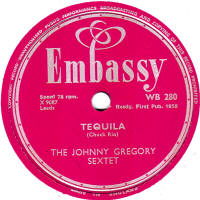
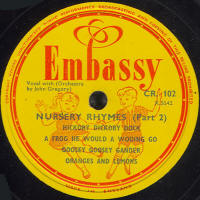
1. The first was a double-sided "Nicole" record, pressed on the same odd material. (Pic. 1). They appear to have used various coloured labels of this same design. (My thanks to Norman Field for providing this label scan)
2. The second appeared in 1911 and used Dacapo masters (Pic 2).
3. The next was actually called New Empire and was a Edison Bell product (the purple one shown here).
4. The colourful one pictured here was a Piccadilly subsidiary, appearing briefly in 1931, with a catalogue running from E-1 to E-12.
5. Next there was a flexible record, similar to Filmophone in material (not seen and not shown here)
6. Finally another shellac, a subsidiary of Octacros, produced for Metropolitan Stores during 1936-37, with an E-100 catalogue series (the red one here).
Footnote:- I believe that the name "Empire Recored" was also used on a "paste-over" label in the WWI period, but I have no examples and no further information as to what was being sold off in this manner.
_small.jpg)
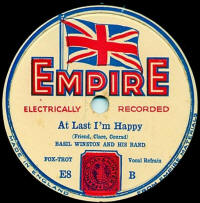
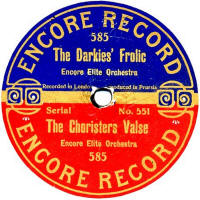
Era was a registered trade mark of William R. Petty, a watchmaker, of The Poplars, Bowes Rd, New Southgate, Middx, as from October 1907. He registered the name to cover talking machines and disc records, with the design shown on the label here as the trade mark. However, Frank was unable to find any link betweek Petty and those who were known to sell these records, which were The New Polyphon Supply Co, Barnet Samuel & Sons & John G Murdoch & Co. All in all, there is some mystery still behind this rare and early label.
Subsequently (in 1910), Beka became part of the Carl Lindström group, and with it the Era matrices. In March 1911, they issued a new Era label, not using Petty's trade mark, but with a new, simpler design incorporated the "£" ( 'L' for Lindström) symbol later associated in Britian with Parlophone (which was part of the Lindström group of companies). These were double-sided records, with the catalogue number still matching the parent Beka issue. (See second example).
Thanks to Bill Dean-Myatt for providing the first label photo. Thanks to Adrian Smith, I now have a colour image of the later Era Record label. As ever, digitising red labels is tricky, and I suspect it should be a darker red with gold printing.
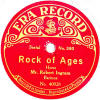
These recordings would be acoustically made, as Crystalate hadn't yet adopted the new electrical recording system.
The label image has been send to me by Thomas Preece, and I have included the matrix number in the image as a guide.
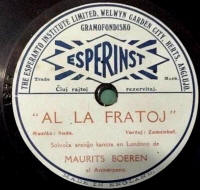
While Esquire concentrated mainly on jazz, there were other series. Thanks to Peter Adamson, I can show an image of one of the fairly scarce Esquire black labelled 12" classical series. These were expensive at 11/6 each!
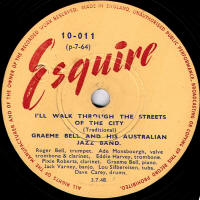
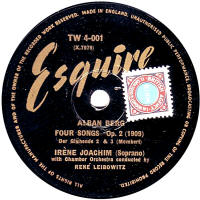
From the style of the label, I would say these records date from the mid-to-late 1950s.
Thanks to Bill Dean-Myatt for providing the label photo.
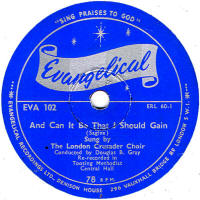
Based on the known issues, it would appear that the catalogue ran from No. 301 to the 340s. They may even have all been issued in one lot. Certainly, judging by their scarcity, they were probably not on sale for very long.
Frank Andrews reports different series of catalogue numbers: a 2000- series for the Edison Bell ones, a 5000 and 8000 series for the Polyphons and a 3-digit catalogue number for the Invicta/Guardsman ones, though some of the latter have no catalogue numbers at all. These catalogue series sound very like the ones used on the source labels, but the few I have been able to check don't match this, so it is just a coincidence, it seems.
The basic design was similar for all, though some are believed to be just pasted over "Guardsman" records.
My thanks to Derek Kell for providing the label scan.
